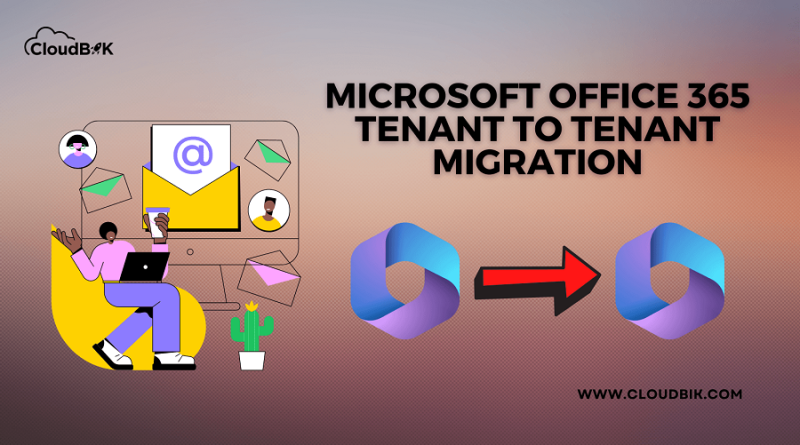Office 365 Tenant to Tenant Migration: A Comprehensive Guide
Nowadays organizations are always looking for ways to improve their efficiency and productivity. One way to achieve this goal is by adopting cloud-based solutions, such as Office 365 that offer a wide range of productivity tools and services. However, as businesses grow and change, there may come a time when they need to move their Office 365 data from one tenant to another and for moving mailboxes from one tenant to another tenant in Microsoft 365 you need to perform Office 365 Tenant to Tenant Migration procedure, and it can be a complex and challenging task if not approached correctly.
In this article, we will take a closer look at Office 365 tenant to tenant migration, exploring the method to perform tenant to tenant migration in Microsoft Office 365, and the key considerations that organizations need to keep in mind.
Note: You should have admin login credentials to perform the tenant to tenant migration.
How to perform Office 365 Tenant to Tenant Migration?
In this section, we will see the necessary steps required for performing tenant-to-tenant migration in Microsoft 365.
Prepare the source tenant:
In the source tenant, we need to create a mail-enabled security group and add all the members in that mail-enabled security group that we need to migrate to a new tenant in Microsoft 365. This is a necessary requirement to perform Office 365 Tenant to Tenant Migration.
- Create mail-enabled security group in the source tenant
- Find and copy the Tenant ID of the source and target tenant
Prepare the target tenant:
In the target tenant, you need to create a migration application, provide API permission in the application, add a client secret value, and grant admin consent for MSFT. After this, we also need to create mail users in the target tenant to fulfill some requirements of Office 365 Tenant to Tenant Migration.
- Create a migration application and generate a secret value in the target tenant
- Create or register an application
- Provide API Permission
- Add new Client Secret
- Grant Admin Consent for MSFT
- Create mail users in the target tenant.
Create a migration endpoint for Office 365 Tenant to Tenant Migration:
A migration endpoint is a connection between the source and target tenants that allows you to transfer data from one to the other. You need to create a migration endpoint and organization relationship in the target tenant using Windows PowerShell for the migration.
- Create the migration endpoint and organization relationship in the Target Tenant
Accept the Migration Application and Organization Relationship:
We need to accept the migration application and organization relationship in the source tenant that we created in the target tenant for mapping the source tenant and the target tenant in Microsoft 365. This is required when performing Office 365 to Office 365 Migration.
Map the source tenant mailboxes to the target tenant:
You need to map the source data to the target tenant so that the migration process knows where to place the data.
- Find ExchangeGuid and LegaceExchangeDN of source mailbox
- Add ExchangeGuid and LegaceExchangeDN in Target Tenant
This will map the Exchange GUID and Legacy Exchange DN of the source tenant to the target tenant to migrate mailboxes from the source tenant to the target tenant in Microsoft 365.
Test the Migration Server Availability and Assign Licenses to the Mail Users:
Once you have completed all the steps shown above you need to test the migration server availability. If the test result shows success then you are good to go to complete the tenant to tenant migration. But if the test result shows false you need to check any mistakes you made from the start or you may need to do the complete process again. After testing you need to assign licenses to the mail users you created in the target tenant.
- Test migration server availability
- Assign Licenses to the mail users created earlier in Target or destination Tenant
Start the Office 365 tenant to tenant migration:
Once the source data is mapped to the target tenant, you can start the migration process. You can use the Office 365 Migration option to add the migration batch to complete the Office 365 Tenant to Tenant Migration process.
- Create a Migration Batch in Target Tenant
Monitor the migration:
You should monitor the migration process to ensure that it is running smoothly and that no errors are encountered. You can check the Office 365 tenant to tenant migration progress in the migration tab.
Note: This process is complex and time-consuming, so it is recommended that you follow all the instructions and steps carefully to avoid any errors.
You can follow the above steps to perform tenant to tenant migration in Microsoft 365. To read these steps in detail with the relevant pictures, visit this guide on Tenant to Tenant Migration.
Conclusion:
Tenant to tenant migration is a process of moving mailbox data from one one tenant to another. Multiple steps are needed to perform, including preparation of the source and target tenants, creation of a migration endpoint, mapping the source data to the target tenant, starting the migration, and monitoring the migration. Proper planning and preparation, as well as careful execution of the migration steps, will help ensure a successful Office 365 to Office 365 migration.
Read More: 10 Reasons Why All-in-One Computers Rule Your Desk

